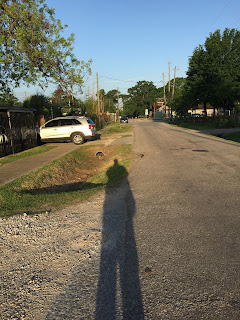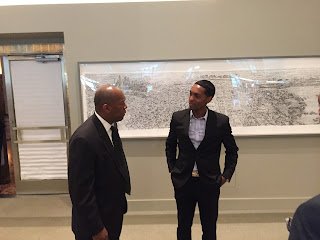At least that is the way I am thinking about it. It is wonderful that the city is moving towards having an innovation district and that there are a host of collaborative groups. I will continue to work for nodes of this district to be placed in our neighborhood. In the meanwhile that this is on the Red Line and Rice is involved I see as a very positive effort.
Mayor and Rice President Announcement of Announcement
The picture is next to where Blue 1647 began so hopefully there will be many and as much education for all ages provided in our district just as we have begun with the great folks at The Castillo Center.
And so a bunch of photos that hopefully later I will add words for.
As this blog is written mainly for my own pleasure so even though Google invites me as journalist to various events I have declined offers to write in more recognized forums and so for about fifteen minutes I was checked out by Rice PR then allowed into this wonderful old building. The story neither begins nor ends here and I will try to bring the story to you and also link to others telling this story. I catch the train on Fulton and Cavalcade. William Fulton wrote about how to make an innovation district
work.
Continued reading from The Edward's Edition:
ON THE ISSUES: The Big Announcement - Houston's Innovation District
"The future belongs to those who see possibilities before they become obvious." - John Sculley, Entrepreneur
A vibrant
place where the possibilities of the future are both imagined then
transformed into reality will soon come to fruition in Houston and will
be known as Houston's Innovation District. In so many technology and
innovation ecosystems across the world, innovation districts were once a
far cry from accepted reality of the status quo when they were first
imagined. From the Innovation District in Shanghai, China to Silicon
Valley in California, innovation districts have now become prominent
features of numerous technology and innovation ecosystems across the
globe, as they help to cultivate innovation economies. According to the
Brookings Institute, innovation districts make their cities more dynamic
by creating an atmosphere of "open innovation," whereby ideas and
knowledge can be transferred seamlessly among institutions, firms and
workers.[2]
Innovation districts build strong links between shaping the economy,
building spaces and networking socially. They also innovation districts
can provide a strong foundation for job growth, offer new education and
employment opportunities, and they can combat urban sprawl and promote
mass transit.[3]
In just a few months after the closure of Sears in Midtown, Dr. David Leebron of Rice University (who owns the 9-acre tract)[4]
led the effort to transform what had been merely a recommendation from
the final report of the Mayor's Task Force for Technology &
Innovation[5]
and other ecosystem experts (including Accenture) to firm plans to
develop Houston's Innovation District - starting with the old Sears
building in Midtown Houston.
While Houston
proves to be the most diverse city in the country, the "Energy Capital
of the World," home to the world's largest medical center - The Texas
Medical Center, home to NASA, home to the second busiest port in the
nation[6],
and may tout many other strengths, Houston has not been remotely close
to reaching its potential relating to venture capital investment and the
cultivation of technology & innovation start-ups. With cities like
Chicago going from $390 Million in venture capital investment in 2012 to
an astounding $1.7Billion within 5 years according to the Built In Chicago Annual Report for 2016[7], due, in part, to the creation of their technology start-up center, known as 1871[8]
and other high profile wins like the success of Groupon and Google's
office there, the need for Houston to be much more strategic,
collaborative and innovative in cultivating an innovation ecosystem
could not be more evident. Houston's Innovation District serves as one
important step in cultivating a more robust Houston innovation economy.
Details on Houston's Innovation District
Houston's new
Innovation District will convert the Sears building (while preserving
its Art Deco features) and the surrounding 9-acre site into a
transformative destination where technology and innovation start-ups,
academics and entrepreneurs can come together to help promote Houston
as a center for technology and innovation.[9]
Its proximity to Downtown and the Texas Medical Center and access to
transit also will help investors and corporations have easy access to
the Innovation District. The Innovation District will be comprised of
varied co-working spaces and present opportunities to engage in
cross-industry collaborations, host labs where companies can show off
prototype projects, and provide academic expertise and support - not
only from Rice University but from myriad universities including, but
not limited to the University of Houston, the University of Houston
Downtown, Texas Southern University, University of St. Thomas and
Houston Community College. The Innovation District will also include a
shared space of amenities and collaborative programming, helping to
connect Houston with a variety of businesses - established and new.[10]
Midtown sits
at the intersection of many of Houston's diverse neighborhoods,
including Downtown, Montrose, the Museum District, the Third Ward, and
the Sears building will be close to Houston's Metro light rail - red
line, providing public transportation links and walkability. The
Innovation District in Midtown will have room to grow, can take
advantage of Houston's diversity, and may connect diverse communities.
The first phase of development (the Sears building renovation) is expected to be completed by early 2020.[11]
The timeline for future developments is not yet known, but the Rice
Management Company has said they will spend $100 million developing the
building, and President Leebron has high hopes for the project, as he
stated, "[w]e expect the successful development of this hub, along with
other centers of innovation located elsewhere in the city, to drive
Houston's reputation as a center for innovation and start-up companies
and provide jobs and related educational opportunities."[12]
Rice has likened the plans for the proposed Innovation District to
other innovation hubs sponsored by major universities, such as the
University of California: San Francisco's (UCSF) Mission Bay in San
Francisco and Georgia Tech's Tech Square in Atlanta,[13] so Houstonians can expect great things from this important project.
From Pen & Paper to Reality
The
announcement of Houston's Innovation District serves as a substantial
leap into the implementation phase of the tireless plans and efforts of
many, including the Mayor's Technology & Innovation Task Force (the
"Task Force"), which was initiated and led by Council Member Edwards.[14]
In fact, Council Member Edwards authored a budget amendment in 2016 to
create the Task Force to cultivate a more robust technology and
innovation start up ecosystem in Houston to promote economic growth in
Houston. Culminating with a final report presented to the Mayor and City
Council in June 2017, the Task Force (comprised of wide variety of
leaders in academia, corporations, venture capital investment, start-ups
and the government) studied Houston's ecosystem assets and other
ecosystems, and even visited Cincinnati and Chicago to figure out what
the "secret sauce" to success might be. Throughout these efforts, the
importance of "collisions" for investors and start-ups to make easy
connections, as well as to help facilitate collaboration among
start-ups, among other benefits, kept being emphasized. Concentrating
start-ups in a district makes it easier on venture capital investors to
engage start-ups more efficiently. In addition, by creating dense
work-play-live environments that include coffee shops, eateries,
start-up co-working space and other features, via innovation districts,
start-ups have access to more opportunity to thrive, which is why the
recommendation of an innovation district was a prominent aspect of the
Task Force final report.
Houston's Innovation District Fits the Task Force Criteria
The Task Force
purposely did not identify winners and losers regarding the Innovation
District recommendation; rather, it established criteria of elements the
proposed Innovation District should include. Specifically, in the final
report of the Task Force[15], the following criteria were established as key ingredients for Houston's Innovation District:
- Be able to grow in density so that
other ecosystem players (corporations, investors, research and academia,
service providers & international companies) can participate and
locate in the district.
- Be a focal point of Houston's culture and entrepreneurial spirit, featuring eateries that celebrate Houston's diversity.
- Balance live, work and play and have easy access to multi-modal transit options and walkable places.
- Be Inclusive.
- Be an ideal location to implement smart city technologies.
In an effort
to promote more inclusion, the report also recommended that a liaison be
designated to drive connectivity between the Innovation District and
Complete Communities Initiative, including programming, events and
training opportunities.
The Innovation
District will fit the criteria established by the Task Force, as its
proximity to both Downtown and The Texas Medical Center along the light
rail line (red line) will connect corporations (customers), investors
and academia to start-ups in the District. By owning several acres that
can be further expanded, additional eateries can be enticed that
supplement the strong eatery base of Midtown. This District can be a
connector of diverse communities and be a site where multi-modal transit
options, walkable places and smart city technologies are further
promoted and embraced.
Future of Technology & Innovation in Houston
Council Member
Edwards often remarks to youth that their futures are only limited by
their own imaginations. The same holds true for Houston. Houston has had
the raw ingredients for a robust innovation ecosystem for a long time,
but has never had a winning recipe for success or a critical mass of the
ecosystem stakeholders present at the same table at the same time. Now,
the City of Houston (government), academia, the corporations, the
investment community, and the start-up community are all at the same
table ready to move the innovation ball forward in a substantial way.
Doing so will enable Houston to become a "city of the future" in so many
arenas. Stay tuned for more updates regarding Houston's Innovation
District and more efforts to build our technology and innovation
ecosystem.


[5]
Pursuant to Council Member Edwards' budget amendment, the Mayor's Task
Force for Technology & Innovation Task Force was created. Council
Member Edwards helped lead the Task Force comprised of the following
leaders: John Reale, Jr. (Task Force Chair) (Station Houston); Jeff
Reichman (January Advisors); Bill McKeon (Texas Medical Center); Lori
Vetters (Houston Technology Center); Gina Luna (Luna Strategies); Dan
Jacobs (NASA); Aziz Gilani (Mercury Fund); Paul Cannings (RPH
Consulting); Yael Hochberg (Rice University); Ken Jones (University of
Houston); and Carol Lewis (Texas Southern University).
[6] Houston Has the Busiest Seaport in the U.S. by Kiah Collier
[7]2016 Chicago Startup Report: $1.7B in Funding and 55 Exits by Andreas Rekdal:
An Unexpected Source of Innovation: Chicago Tech Center 1871 Expands by Vicki Gerson
[9] Innovation Hub In Former Sears Is Houston's Answer To Amazon's Snub by Kyle Haggerty
[10] Rice University Internal Innovation District Announcement Presentation
[14] John Reale served as chair of the Task Force.
 | | | | |
| Shadow of myself as I walk to the train on a narrow street in the small square of God's green earth that I call Home and Lindale |
|
|
|










